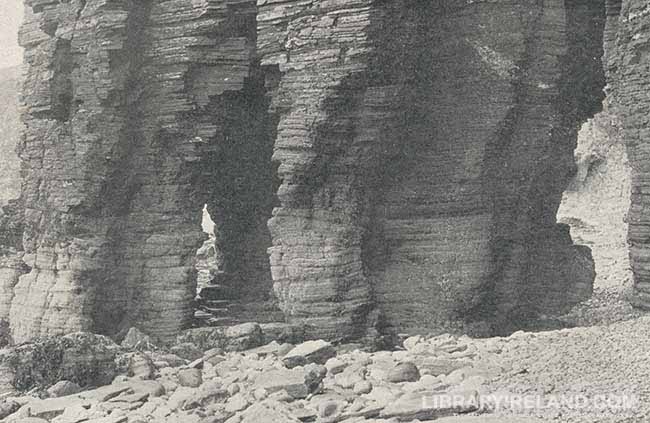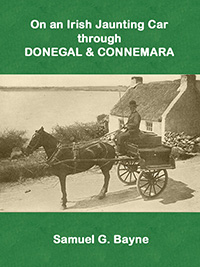Cathedral Cliffs at Menawn
The island contains the cathedral cliffs of Menawn, one thousand feet in height, hollowed by the long action of the waves through countless centuries, and having a striking resemblance to stupendous Gothic aisles.

The Cathedral Cliffs of Menawn
We started early in the morning for Achill Head, via Keem Bay, traveling as usual on a car, driven by a boy. We drove through a unique fishing village, consisting of very small houses laid out in regular streets, the thatched roofs being secured against the winter storms by ropes on which were hung large stones about the size of watermelons. These rows of stones swayed in the wind and produced a curious effect while in motion. The car stopped at the foot-hills, where the road changed into a path, and waited under a shed for our return in the evening. On alighting we were delighted to hear the sweet, familiar song of a pair of larks that soared up under the clear, blue sky so far above our heads that they seemed mere specks which we could see but indistinctly. It was many years since we had seen and heard the Irish lark in its native element, and we listened to the notes with keen, reminiscent pleasure.
Here we hired two gillies to help us in climbing Achill Head, which is quite a high mountain. We climbed up a steep track for about three miles, and were congratulating ourselves upon our progress, when, on rounding the hip of the hill, we discovered that we should have to descend again to sea-level at Keem Bay, in order to commence the real ordeal. It was easy work going down, and we soon reached the bay. This is a beautiful spot, an indenture in the headland, with a firm, yellow strand at the head, and perpendicular, rocky bluffs on its sides. Three large boats were salmon-fishing, and from the many places where we rested on our long climb up the mountain we saw them tacking back and forth all day.
Near the shore we visited the house and store of Captain Boycott, both in ruins. This is the gentleman who gave us a new word for our vocabulary. Notwithstanding his fate, he had many warm friends among the peasantry.
We started climbing again by following the bed of a brawling stream, and adhered to it until it turned into a rivulet. Most Irish mountains are formed by a series of benches, and our plan was to climb briskly till we reached a bench and there make a recovery for the next assault. As we rose in the air we felt our clothing becoming burdensome, and we gave one article after another to the gillies, so that by the time we reached the top our wardrobes were quite elementary. It seemed to us that all the benches in Ireland were collected on that mountain; each one was to have been the last, but still there was another and yet another. We finally reached the summit and, bathed in perspiration, lay down on the heather, wrapping ourselves in rain-coats, and, telling the gillies to wake us in an hour, fell asleep. It would not have been much of a climb for a mountaineer, but for us, of full habit and totally untrained, it was exercise to the extreme limit of endurance.
Read "On an Irish Jaunting Car through Donegal and Connemara" at your leisure
Read On an Irish jaunting Car through Donegal and Connemara at your leisure and help support this free Irish library.
Samuel Gamble Bayne was born in Ramelton, County Donegal, and educated at Queen's University in Belfast. At the age of twenty-five he left for America with a view to making his fortune. He invested in an oil well in Pennsylvania and later founded a bank which subsequently came to be the JP Morgan Chase bank in New York. By the time this book was written he was wealthy enough to be referred to as a billionaire. His account of the tour through the north, west and south of Ireland is a pleasant snapshot of how that part of the country was in the early part of the 20th century. He describes what is to be seen, gives some background history and, through the illustrations especially, provides wonderful glimpses of the area's social history.
The ebook is available in .mobi, .epub, and .pdf formats. See details ».

